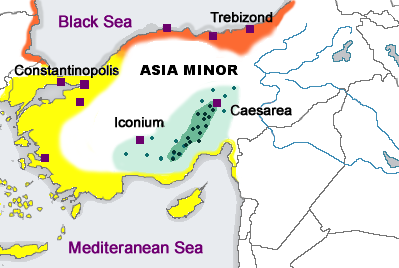|
Hippiatrica
The ''Hippiatrica'' () is a Byzantine compilation of ancient Greek texts, mainly excerpts, dedicated to the care and healing of the horse.. The texts were probably compiled in the fifth or sixth century AD by an unknown editor. Currently, the compilation is preserved in five recensions in 22 manuscripts (containing 25 copies) ranging in date from the 10th to the 16th centuries AD. Contents Seven texts from Late Antiquity constitute the main sources of the ''Hippiatrica'': the veterinary manuals of Apsyrtus, Eumelus (a veterinary practitioner in Thebes, Greece) Hierocles, Hippocrates, and Theomnestus, as well as the work of Pelagonius (originally a Latin text translated into Greek), and the chapter on horses from the agricultural compilation of Anatolius.. Although the aforementioned authors allude to their classical Greek veterinary predecessors (i.e. Xenophon and Simon of Athens), the roots of their tradition mainly lie in Hellenistic agricultural literature derived from Mago ... [...More Info...] [...Related Items...] OR: [Wikipedia] [Google] [Baidu] |
History Of Veterinary Medicine
Veterinary medicine is the branch of medicine that deals with the prevention, management, diagnosis, and treatment of disease, disorder, and injury in non-human animals. The scope of veterinary medicine is wide, covering all animal species, both domesticated and wild, with a wide range of conditions that can affect different species. Veterinary medicine is widely practiced, both with and without professional supervision. Professional care is most often led by a veterinary physician (also known as a veterinarian, veterinary surgeon, or "vet"), but also by paraveterinary workers, such as veterinary nurses, veterinary technicians, and veterinary assistants. This can be augmented by other paraprofessionals with specific specialties, such as animal physiotherapy or dentistry, and species-relevant roles such as farriers. Veterinary science helps human health through the monitoring and control of zoonotic disease (infectious disease transmitted from nonhuman animals to humans), fo ... [...More Info...] [...Related Items...] OR: [Wikipedia] [Google] [Baidu] |
Veterinary Medicine
Veterinary medicine is the branch of medicine that deals with the prevention, management, medical diagnosis, diagnosis, and treatment of disease, disorder, and injury in non-human animals. The scope of veterinary medicine is wide, covering all animal species, both List of domesticated animals, domesticated and wildlife, wild, with a wide range of conditions that can affect different species. Veterinary medicine is widely practiced, both with and without professional supervision. Professional care is most often led by a veterinarian, veterinary physician (also known as a veterinarian, veterinary surgeon, or "vet"), but also by paraveterinary workers, such as veterinary nurses, veterinary technicians, and veterinary assistants. This can be augmented by other paraprofessionals with specific specialties, such as animal physiotherapy or dentistry, and species-relevant roles such as farriers. Veterinary science helps human health through the monitoring and control of Zoonosis, zoonoti ... [...More Info...] [...Related Items...] OR: [Wikipedia] [Google] [Baidu] |
Simon Of Athens
Simon of Athens was an Athenian writer on horses and horsemanship of the fifth century BC. He is the earliest known ancient Greek writer on the subject; Pliny described him as , "the first to have written on riding". His writings are quoted by Xenophon. Life It is not known when Simon lived. However, it cannot have been much before 460 BC, as he is known to have criticised a work of the Athenian painter Micon, who lived at about that time. Simon is the earliest writer of ancient Greece known to have written on horses and horsemanship, and was described by Pliny as , "the first to have written on riding". According to Xenophon, Simon dedicated a bronze statue of a horse, on a plinth decorated with reliefs of his deeds, in the Eleusinion in the Agora of Athens. Works Simon's writings are quoted by Xenophon, who refers to him both in the '' Hipparchikós'' () and in '' Perì hippikēs'' (, "on horsemanship"). A fragment attributed to him is contained in the Byzantine ... [...More Info...] [...Related Items...] OR: [Wikipedia] [Google] [Baidu] |
Pelagonius
Pelagonius (4th century AD) was an influential Latin writer on veterinary medicine, especially on horses. He is one of the many authors whose work was compiled and preserved in the ''Hippiatrica''. Remains of his texts still exist in Latin and Greek. One of his sources was Columella. He was used by Vegetius. There is an edition of his texts in Teubner The Bibliotheca Teubneriana, or ''Bibliotheca Scriptorum Graecorum et Romanorum Teubneriana'', also known as Teubner editions of Greek and Latin texts, comprise one of the most thorough modern collections published of ancient (and some medieva ... (1980), ''De veterinaria medicina'', by K.D. Fischer. References Sources * External linksPelagoniusstudies and digitized texts by thBIUM (Bibliothèque interuniversitaire de médecine et d'odontologie, Paris)see its digital librar Ancient Roman writers Science writers 4th-century writers in Latin Ancient Roman veterinarians {{Europe-writer-stub ... [...More Info...] [...Related Items...] OR: [Wikipedia] [Google] [Baidu] |
Byzantine Empire
The Byzantine Empire, also known as the Eastern Roman Empire, was the continuation of the Roman Empire centred on Constantinople during late antiquity and the Middle Ages. Having survived History of the Roman Empire, the events that caused the fall of the Western Roman Empire in the 5th centuryAD, it endured until the fall of Constantinople to the Ottoman Empire in 1453. The term 'Byzantine Empire' was coined only after its demise; its citizens used the term 'Roman Empire' and called themselves 'Romans'. During the early centuries of the Roman Empire, the western provinces were Romanization (cultural), Latinised, but the eastern parts kept their Hellenistic culture. Constantine the Great, Constantine I () legalised Christianity and moved the capital to Constantinople. Theodosius I, Theodosius I () made Christianity the state religion and Greek gradually replaced Latin for official use. The empire adopted a defensive strategy and, throughout its remaining history, expe ... [...More Info...] [...Related Items...] OR: [Wikipedia] [Google] [Baidu] |
Aetiology
Etiology (; alternatively spelled aetiology or ætiology) is the study of causation or origination. The word is derived from the Greek word ''()'', meaning "giving a reason for" (). More completely, etiology is the study of the causes, origins, or reasons behind the way that things are, or the way they function, or it can refer to the causes themselves. The word is commonly used in medicine (pertaining to causes of disease or illness) and in philosophy, but also in physics, biology, psychology, political science, geography, cosmology, spatial analysis and theology in reference to the causes or origins of various phenomena. In the past, when many physical phenomena were not well understood or when histories were not recorded, myths often arose to provide etiologies. Thus, an etiological myth, or origin myth, is a myth that has arisen, been told over time or written to explain the origins of various social or natural phenomena. For example, Virgil's ''Aeneid'' is a national myth ... [...More Info...] [...Related Items...] OR: [Wikipedia] [Google] [Baidu] |
Byzantine Medicine
Byzantine medicine encompasses the common medical practices of the Byzantine Empire from c. 400 AD to 1453 AD. Byzantine medicine was notable for building upon the knowledge base developed by its Greco-Roman predecessors. In preserving medical practices from antiquity, Byzantine medicine influenced Islamic medicine and fostered the Western rebirth of medicine during the Renaissance. The concept of the hospital appeared in Byzantine Empire as an institution to offer medical care and possibility of a cure for the patients because of the ideals of Christian charity. Byzantine physicians often compiled and standardized medical knowledge into textbooks. Their records tended to include both diagnostic explanations and technical drawings. The Medical Compendium in Seven Books, written by the leading physician Paul of Aegina, survived as a particularly thorough source of medical knowledge. This compendium, written in the late seventh century, remained in use as a standard textbook for th ... [...More Info...] [...Related Items...] OR: [Wikipedia] [Google] [Baidu] |
Byzantine Literature
Byzantine literature is the Greek literature of the Middle Ages, whether written in the Byzantine Empire or outside its borders. It was marked by a linguistic diglossy; two distinct forms of Byzantine Greek were used, a scholarly dialect based on Attic Greek, and a vernacular based on Koine Greek. Most scholars consider 'literature' to include all medieval Greek texts, but some define it with specific constraints. Byzantine literature is the successor to Ancient Greek literature and forms the basis of Modern Greek literature, although it overlaps with both periods. The tradition saw the competing influences of Hellenism, Christianity, and earlier in the empire's history, Paganism. There was a general flourishing of gnomai, hagiography, sermons, and particularly historiography, which became less individual-focused. Poetry was often limited to musical hymnal forms, or the more niche epigram tradition, while ancient Theatre of ancient Greece, dramas and Epic poetry, epics beca ... [...More Info...] [...Related Items...] OR: [Wikipedia] [Google] [Baidu] |
Cure
A cure is a substance or procedure that resolves a medical condition. This may include a medication, a surgery, surgical operation, a lifestyle change, or even a philosophical shift that alleviates a person's suffering or achieves a state of healing. The medical condition can be a disease, mental illness, genetic disorder, or a condition considered socially undesirable, such as baldness or insufficient breast tissue. An incurable disease is not necessarily a terminal illness, and conversely, a curable illness can still be fatal. The cure fraction or cure rate—the proportion of people with a disease who are cured by a given treatment—is determined by comparing disease-free survival in treated individuals against a matched control group without the disease. Another method for determining the cure fraction and/or "cure time" involves measuring when the hazard rate in a diseased group returns to the hazard rate observed in the general population. The concept of a cure inherently ... [...More Info...] [...Related Items...] OR: [Wikipedia] [Google] [Baidu] |
Medieval Greek
Medieval Greek (also known as Middle Greek, Byzantine Greek, or Romaic; Greek: ) is the stage of the Greek language between the end of classical antiquity in the 5th–6th centuries and the end of the Middle Ages, conventionally dated to the Ottoman conquest of Constantinople in 1453. From the 7th century onwards, Greek was the only language of administration and government in the Byzantine Empire. This stage of language is thus described as Byzantine Greek. The study of the Medieval Greek language and literature is a branch of Byzantine studies, the study of the history and culture of the Byzantine Empire. The conquests of Alexander the Great, and the ensuing Hellenistic period, had caused Greek to spread throughout Anatolia and the Eastern Mediterranean. The beginning of Medieval Greek is occasionally dated back to as early as the 4th century, either to 330 AD, when the political centre of the Roman Empire was moved to Constantinople, or to 395 AD, the division o ... [...More Info...] [...Related Items...] OR: [Wikipedia] [Google] [Baidu] |
Centaur
A centaur ( ; ; ), occasionally hippocentaur, also called Ixionidae (), is a creature from Greek mythology with the upper body of a human and the lower body and legs of a horse that was said to live in the mountains of Thessaly. In one version of the myth, the centaurs were named after Centaurus (Greek mythology), Centaurus, and, through his brother Lapithes (hero), Lapithes, were kin to the legendary tribe of the Lapiths. Centaurs are thought of in many Greek myths as being as wild as untamed horses, and were said to have inhabited the region of Magnesia (regional unit), Magnesia and Mount Pelion in Thessaly, the Foloi oak forest in Ancient Elis, Elis, and the Malean peninsula in southern Laconia. Centaurs are subsequently featured in Roman mythology, and were familiar figures in the medieval bestiary. They remain a staple of modern fantastic literature. Etymology The Greek word ''kentauros'' is generally regarded as being of obscure origin. The etymology from ''ken'' + ''tau ... [...More Info...] [...Related Items...] OR: [Wikipedia] [Google] [Baidu] |





